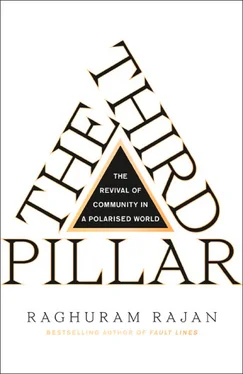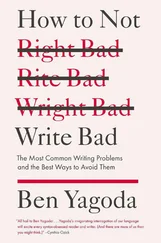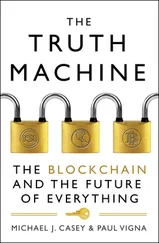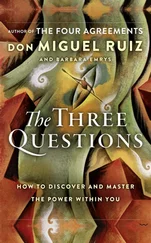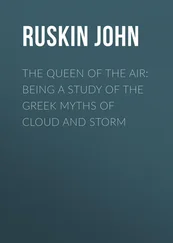Of course, a lender could get around the usury prohibition by disguising interest; for instance, a lender could finance the unlucky tribesman’s purchase of additional goats but demand milk every day in lieu of interest. This is where religion came in. Knowing that God saw what the tribal authorities might overlook, in an age when the fate of the soul was more important than earthly existence, the fear of retribution in afterlife played an effective role in ensuring the usury prohibition was respected in letter and spirit.
The prohibition on charging interest thus helped strengthen communal bonds and mutual support in small poor communities where anyone could be hit by adversity, and the identities of those in need fluctuated almost randomly over time. To be your brother’s keeper, to practice a kind of communism, made sense.
The prohibition was also a form of early consumer protection vis-à-vis outside lenders. With the poor borrower not knowing how to read, having a very rudimentary understanding of interest, and also often being in a position of deep distress, the possibility that dispassionate lenders from outside the community could take advantage of him was substantial. Better, socially conscious thinkers would have argued, to force the community to take responsibility for the poor than to deliver them into the clutches of the moneylender. Indeed, all these reasons also played out in the Church’s attack on usury in Europe in the Middle Ages.
FEUDALISM AND THE CHURCH’S ATTACK ON USURY
In Europe, from the early Middle Ages till about the eleventh century CE, the Church frowned upon the charging of interest on loans but did not prosecute moneylending as a sin. 3However, from about the middle of the eleventh century, the Church moved aggressively to curb usury, regarding any interest as a sin, prohibited by the Bible. The usurer had to repay all interest received during his life in full before he could aspire for salvation. The attempts to suppress usury reached their apex in the Church Councils of Lyon in 1274 and Vienna in 1312. The punishment for moneylenders included not only refusal of confession, absolution, or burial in hallowed ground – terrible penalties in those times of deep faith – but also excommunication of rulers or magistrates of states that permitted usury. The economic historian Richard Tawney writes about ‘innumerable fables of the usurer who was prematurely carried to hell, or whose money turned to withered leaves in his strong box or who … on entering a church to be married, was crushed by a stone figure falling from a porch, which proved by the grace of God, to be a carving of another usurer and his money-bags being carried off by the devil …’ 4
What accounted for the Church’s greater zeal in enforcing the ban on usury from the eleventh century onward? And why did it become far less passionate about rooting out the usurer from the late fourteenth century onward? An understanding of these shifts will give us a better sense of why attitudes toward markets change. First, though, we need to understand the quintessential community in those times in Europe: the feudal manor.
The Feudal Community
Under feudalism, everyone except the king held his share of land in trust from his overlord. Because land, the principal source of value, was not freely saleable, it was allocated to trusted supporters. In return for the use of the land and the overlord’s protection, the vassal swore fealty to the overlord and paid him in kind. If the vassal was capable of fighting, payment was through military service; if he was a peasant, payment was through produce from the land or labour. In a sense, feudal obligations and relationships arose from the land and the produce it generated, neither of which could be marketed.
Feudalism in Europe reached its zenith as the Muslim expansion from the seventh century onward shut off Europe’s access to traditional overseas markets. The proliferation of little principalities as well as banditry reduced the size of markets and increased the cost of transporting goods for trade. 5With little to buy, market transactions and the use of money diminished, and feudal relationships proliferated.
The feudal manor was thus a closed, hierarchical community, producing much of what it consumed. The peasant’s land holdings were typically in the form of strips in two or three large open fields, intermingled with those of his neighbours. Each peasant followed the same rotation of crops as the others, and had free access to common pastures and woods where each peasant had grazing rights for a certain number of cattle, sheep, or pigs, as well as the right to collect firewood. All this required a fair amount of coordination and give-and-take (the strips were not separated by fences and the commons were open to all in the manor), which required building consensus in the community.
Each peasant had enough to ensure a subsistence existence. There was little incentive to produce more, since there was not much of a market to sell the surplus in. 6Because the peasant was tied to the land, though, the feudal community was stable, albeit poor. As one historian noted, ‘Most men have never seen more than a hundred separate individuals in the course of their whole lives, where most households live by tilling their great-grandfather’s fields with their great-grandfather’s plough.’ 7
The Commercial Revolution
The nonmonetary feudal economy did relatively well when there were few trading opportunities. Over time, though, Europe learned to trade with, and through, the Muslim lands. Moreover, demand for agricultural products from the growing towns, as well as travel routes that were safer from brigands, helped the revival of trade and commerce. Feudal lords now not only had the opportunity to convert the manor’s produce into money, the money could buy an increasing variety of goods. The growing attraction of producing for, and consuming from, the market did not sit well with traditional feudal practice.
For key to the feudal system was that the individual did not own the land outright; instead, the peasant managed it while he was able-bodied and passed the management on to his kin when he could no longer manage. 8Everyone in the family had customary rights to the land, which made those rights difficult to sell or turn over. In turn, this ensured that a long-lived community built around that land, but productivity was generally low, since a farmer’s kin were not necessarily good farmers. In fact, the absence of a market protected the peasant – his low productivity hurt his household’s production, but did not jeopardize his right to farm land.
As feudal lords became more attracted to monetary income, and as land became easier to sell, this changed. In order to enhance production, the feudal lord had to be able to transfer land to more productive tenants or owners. In England, soon after the turn of the millennium, the courts started overlooking the customary rights of kin, making freehold land easier to bequeath or sell. 9Even tenancy that was tied in with feudal obligations, known as copyhold tenancy, became better defined and easier to transfer over time. 10Scholars argue over whether there was a dramatic change in the legal treatment of property, or whether England was intrinsically more favourable to sales. Whatever the reason, the interests of the Church also lay in freeing property from customary entanglements. If the rights of inheritance, for example, narrowed to direct relatives rather than residing with all kin, land would be easier to bequeath to third parties or to sell. And a primary beneficiary of bequests to third parties was the Church. An elderly childless widow or widower could easily be persuaded that their route to salvation lay in willing the bulk of their property to the Church. Even if they were not persuadable, often the only one who could write down a will or hear last orders was the not entirely disinterested parish priest. 11
Читать дальше
